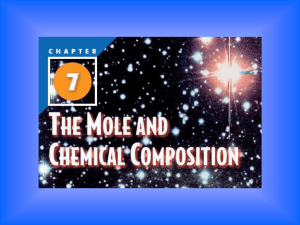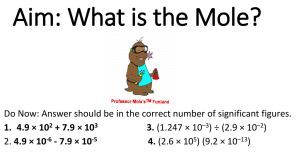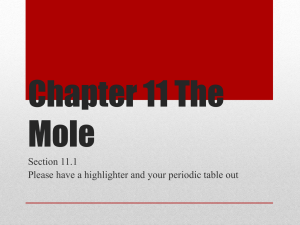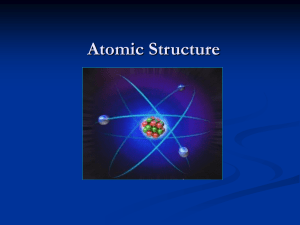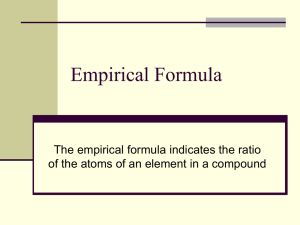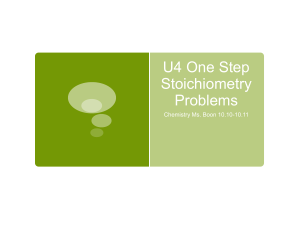TOPIC 3 ATOMIC MASS AND THE CONCEPT OF MOLECULES
advertisement
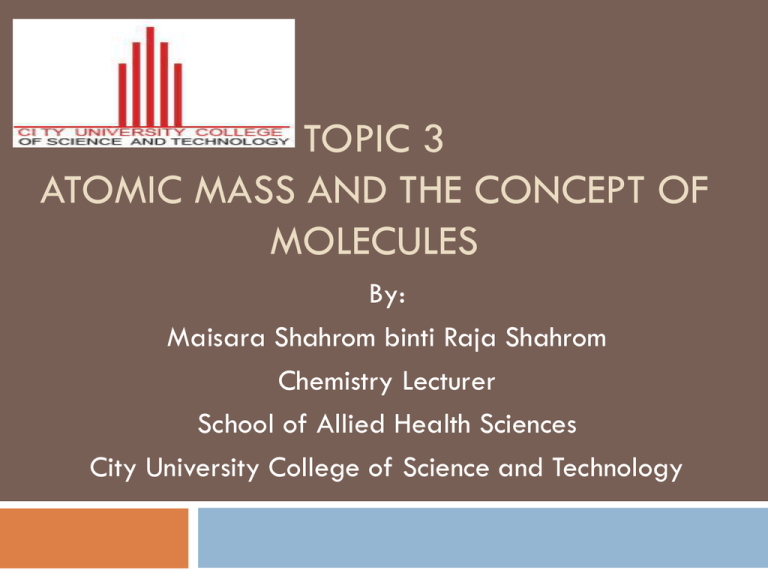
TOPIC 3 ATOMIC MASS AND THE CONCEPT OF MOLECULES By: Maisara Shahrom binti Raja Shahrom Chemistry Lecturer School of Allied Health Sciences City University College of Science and Technology RELATIVE ATOMIC MASS (R.A.M) Relative mass of an atom = Mass of an atom of the element 1/12 of the mass of one atom carbon-12 Why carbon-12 is used as a standard? Its mass can be more easily measured with a mass spectrometer Mass of an atom of the element 1/12 of the mass of one atom carbon-12 Eg. RAM of Mg = RAM of Pb = 24 1/12 x 12 207 1/12 x 12 = 24 = 207 RELATIVE MOLECULAR MASS (R.M.M) A molecule is made up of two or more atoms Calculation of RMM 1. 2. 3. Determined the molecular formula Find the RAM of each element in the molecule Add up of all the RAM of the element Molecule Molecular formula RMM Chlorine Cl2 35.5 x 2 = 72 Nitrogen N2 14 x 2 = 28 Ammonia NH3 14 + (1 x 3) = 17 Ethanol C2H5OH Carbon dioxide CO2 (12 x 2) + (1 x 5) + 16 + 1 = 46 12 + (16 x 2) = 44 LET’S TRY!! Find Relative molecular mass for: (RAM: Cu=64 ; O=16 ; C=12 ; H=1 ; S=32 ; Cl=35.5 ; Na=23) i. CuO ii. CH4 iii. SO2 iv. HCl v. Na2CO3 ANSWER Find Relative molecular mass for: (RAM: Cu=64 ; O=16 ; C=12 ; H=1 ; S=32 ; Cl=35.5 ; Na=23) i. CuO = 80 ii. CH4 = 16 iii. SO2 = 64 iv. HCl = 36.5 v. Na2CO3 = 106 THE MOLE AND THE NUMBER OF PARTICLES In our daily lives, we need to count the amount of objects Pairs and dozen are examples of units that we used In chemistry, we use the unit of mole to measure the amount of substances. 1 pair of shoes = 2 shoes 1 dozen of eggs = 12 eggs 1 mole of carbon = 6.02 x 1023 atoms 1 mole of any element contains 6.02 x 1023 atoms. The value of 6.02 x 1023 atoms is called as Avogadro’s constant AVOGADRO’S CONSTANT = 6.02 x 1023 Key: 1 mole of atom = 6.02 x 1023 particles THE MOLE AND THE MASS OF SUBSTANCE Number of mole atoms = Mass RAM MASS MOLE R.A.M Problem solving Determined the moles How many moles of matter are there in: 1. 5 g of nitrogen, N 2. 10 g of sodium, Na 3. 80 g of carbon, C (RAM: N=14 ; Na=23 ; C=12) MASS MOLE R.A.M Solution: 1. 2. 5 g of nitrogen, N 5 /14 =0.357 moles 10 g of sodium, Na 10/23 = 0.435 moles MASS 3. 80 g of carbon, C 80/12 = 6.67 moles MOLE R.A.M Problem solving Determined the mass How many grams of matter are there in: 1. 2 moles of nitrogen, N 2. 0.5 moles of sodium, Na 3. 6.0 moles of carbon, C (RAM: N=14 ; Na=23 ; C=12) MASS MOLE R.A.M Solution: 1. 2 moles of nitrogen, N 2 x 14 = 28 g 2. 3. 0.5 moles of sodium, Na 0.5 x 23 = 11.5 g 6.0 moles of carbon, C 6.0 x 12 =72 g (RAM: N=14 ; Na=23 ; C=12) MASS MOLE R.A.M Determined The Number Of Particles Number of particles = moles x 6.02 x 1023 1. How many atoms are there in: 0.5 moles of carbon 0.5 x 6.02 x 1023 = 3.01 x 1023 atoms 2. 1.2 moles of sodium 1.2 x 6.02 x 1023 = 7.224 x 1023 atoms Determined The Number Of Moles From The Number Of Atoms Number of moles of atoms = Number of atoms 6.02 x 1023 1. How many moles are there in: 12.04 x 1023 atoms of chlorine 12.04 x 1023 / 6.02 x 1023 = 2 moles 2. 1.02 x 1046 atoms of sodium 1.02 x 1046 / 6.02 x 1023 = 1.69 x 1023 moles ÷ RAM MASS × NA MOLE × RAM NUMBER OF PARTICLES ÷ NA Number Avogadro (NA) = 6.02 x 1023 particles CHEMICAL FORMULA Cation : +ve charge eg: Na+, Mg2+, Al3+… Anion : -ve charge eg: Cl-, O2-, N3-…. If the cation Xm+ and the anion is Yn-, then the formula of the compound is XnYm If m=n, then the formula XY m+ X nY Xn Ym = XnYm Example: Chemical compound Cation Anion Iron (II) chloride Iron (III) chloride Copper (I) sulphate Copper (II) sulphate Fe2+ Fe3+ Cu+ Cu2+ ClClSO2-4 SO2-4 Chemical formula FeCl2 FeCl3 Cu2SO4 CuSO4 Manganese (II) oxide Manganese (III) oxide Manganese (IV) oxide Mn2+ Mn3+ Mn4+ O2O2O2- MnO Mn2O3 MnO2 Empirical formula 1. 2. 3. 4. Step Write the mass of element Calculate the moles Calculate the simplest mole ratio by dividing the each number with the smallest number Write the empirical formula Example Determine the empirical formula of this compound Element Ca Cl Mass 1.6 g 4.26 g RAM 40 35.5 Element Ca Cl Mass 1.6 g 4.26 g Moles 1.6 g / 40 = 0.04 4.26 / 35.5 = 0.12 Simplest ration 0.04 / 0.04 = 1 0.12 / 0.04 = 3 Solution: So, empirical formula = CaCl3 Molecular formula Shows the actual number of atoms of elements that combine to form the compound. (Empirical formula)n = Relative molecular mass Eg: Relative molecular mass of CaCl3 is 293 (CaCl3) n = 293 (40+ (3x35.5)) n = 293 (146.5) n = 293 n=2 So, molecular formula is (CaCl3) n = (CaCl3) 2 = Ca2Cl6 Let’s try 1. 2. 0.19 g of aluminium and 0.79 g atom oxygen are burnt to form aluminium oxide. What is the empirical formula of aluminium oxide [RAM: Al=27 ; O=16) The emipirical formula of ethene is (CH3)n. Its molecular formula mass is 30. Calculate the molecular formula of this compound. Solution 1. Element Mass RAM Moles Ratio x2 Al 0.91 g 27 0.91 / 27 = 0.034 0.034 / 0.034 = 1 2 So, empirical formula is Al2O3 O 0.79 g 16 0.79 / 16 = 0.05 0.05 / 0.034 = 1.5 3 2. The emipirical formula of ethene is (CH3)n. Its molecular formula mass is 30. Calculate the molecular formula of this compound. (CH3)n = 30 (12 + 3)n = 30 (15)n = 30 n=2 So, molecular formula is C2H6 THANK YOU…
